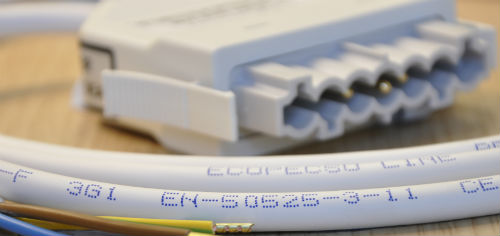As of July 1st this year any power, control or communication cable whose intended use is that of permanent installation in a building or civil engineering project (bridge, tunnel etc.) must be Construction Products Regulation (CPR) compliant and to be that it must carry a Declaration of Performance (DoP). Regardless of whether the product has been manufactured in Belfast or Beijing, if its intended destination is the Europe Union it must have a DoP linked to it and be marked accordingly.

The burning question (no pun intended) has to be whether there will be an immediate impact on the UK’s construction industry? I guess the answer is a definite yes & no, dependant on who you are and where you fit into the supply chain.
Certainly for the cable producer the requirements from 1st July are very clear indeed in that every product manufactured from that date onwards must be CPR compliant; that’s an absolute given. However, products manufactured and placed on the market before that date can still quite legally be sold and bought without an accompanying DoP. ‘Placed on the market’ in this instance is a term that relates to cable manufactured and made available for distributors, wholesalers, installers etc. to buy before 1st July. This commercial standpoint seems only right as it would be grossly unfair on the part of the powers that be in Brussels to expect companies to scrap millions of pounds worth of perfectly good stock simply because it happened to remain unsold after the regulation’s commencement date.
There is as yet no onus on UK decision makers to specify the category of cable required for projects they are working on, but undoubtedly that will filter through over the coming months. Some organisations, Transport for London being one of them, are ahead of the game and have already stated the class of cable they expect for certain applications, but in the main such specifications are, for now at least, few and far between. And this may turn out to be a good thing on the whole as it will allow manufacturers, importers, distributors and wholesalers a sensible period of time to legitimately sell their stocks of pre-July product without having to deal with the constant pressure of their customer base insisting on CPR compliant product. Clearly these stocks will only last for a finite period of time and it won’t be too long before every piece of cable in the UK that needs to be CPR compliant, is. Whether this coincides with the emergence of specifications routinely stipulating the class of cable required project by project remains to be seen, but regardless of how long it takes for the two sides of the construction industry to synchronise, this period of soft integration will surely help in the short term.
What is a Declaration of Performance?
So, what exactly is a Declaration of Performance and what does it tell us? A DoP is the manufacturer’s written and legally binding assurance that should that product be exposed to fire it will react in a known way because it’s been tested in line with EN 50575:2014. This standard dictates, amongst other things, exactly the tests to be carried out and how the results affect the product’s categorisation.
Briefly, the tests are used to determine a product’s potential to contribute to the spread of a fire through:
- Heat given off while burning
- How vigorously it burns
- The likelihood of it setting secondary fires through the production of burning droplets of molten material.
- Transparency of smoke emitted during the burning process
- Acidity of any smoke emitted.
Not all categories are subject to all tests; the higher the Euroclass, the more intensive the testing will be.
Why introduce it?
The aim of the categorisation is to provide manufacturers, distributors, specifiers and installers a means to compare products using uniform criterion, and ensure they select the most appropriate cable product for a project or application. This is something that until now has been difficult to assess as although cable manufacturers state the standards their products are compliant with, unless you’re an expert on the finer details of each and every applicable standard, then making the right call involves either an element of guess work or a time-consuming comparison exercise of technical information provided in different formats by numerous cable manufacturers. On top of that there is still widespread miscomprehension about the difference between LSF and LSHF cable and the safety implications of making the wrong choice. CPR compliancy will make the cable selection procedure far less onerous and much more accurate.
For full details on the categories, and testing carried out, you can visit www.flexconnectors.co.uk/cable
Author: Paul Bellamy, Managing Director at Flex Connectors Ltd.

